BMW X5 3.0I 2001 Owner's Guide
Manufacturer: BMW, Model Year: 2001, Model line: X5 3.0I, Model: BMW X5 3.0I 2001Pages: 223, PDF Size: 2.66 MB
Page 31 of 223
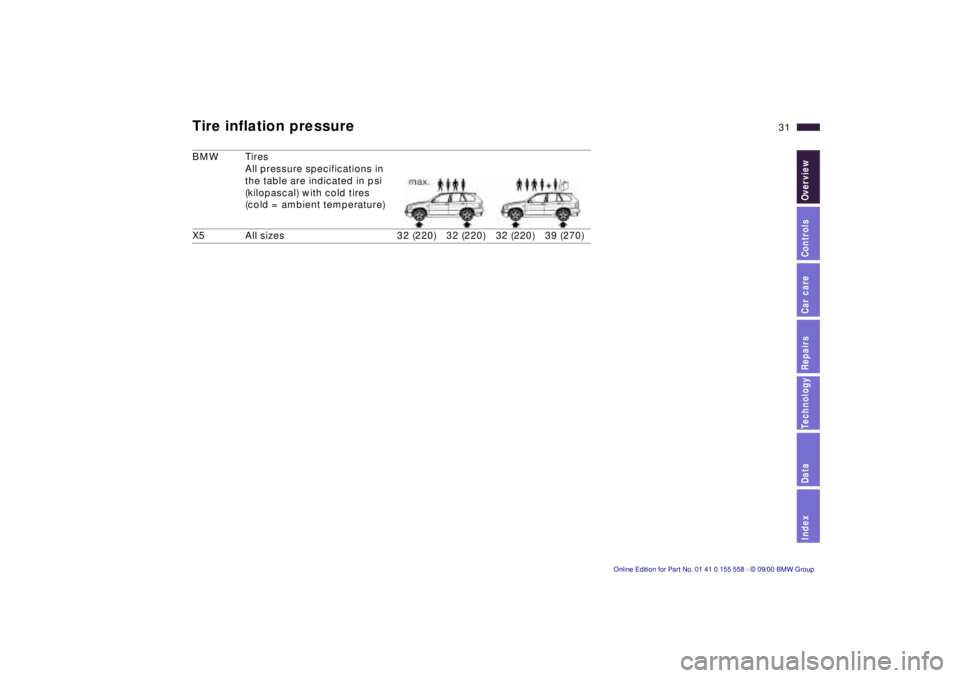
Index
Data
Technology
Repairs
Car care
Controls
Overview
31nTire inflation pressure
BMW Tires
All pressure specifications in
the table are indicated in psi
(kilopascal) with cold tires
(cold = ambient temperature)
X5 All sizes 32 (220) 32 (220) 32 (220) 39 (270)
Page 32 of 223
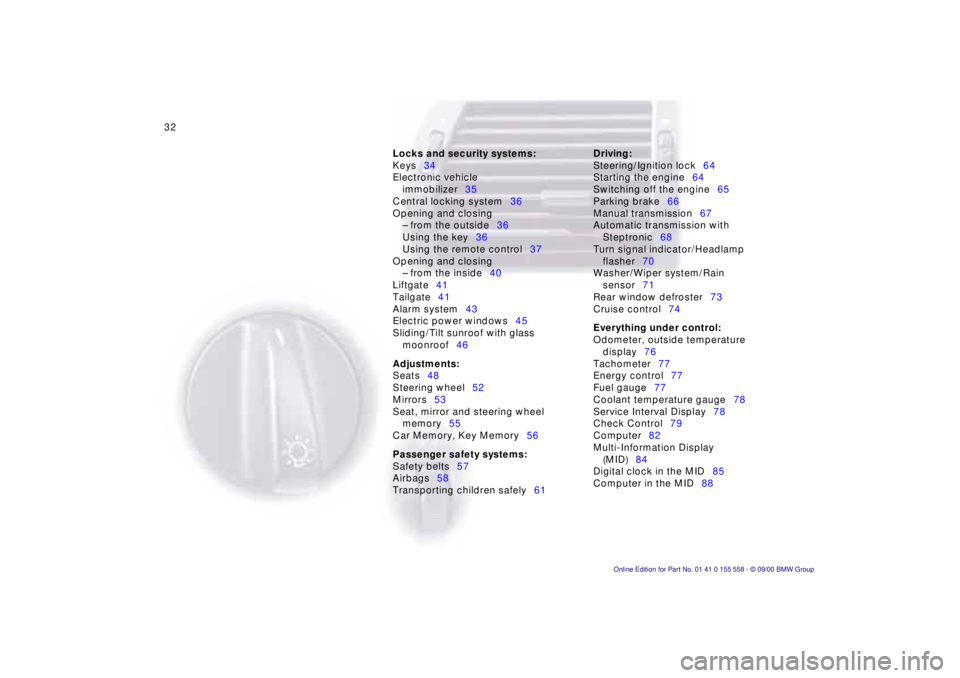
32n
Locks and security systems:
Keys 34
Electronic vehicle immobilizer 35
Central locking system 36
Opening and closing – from the outside 36
Using the key 36
Using the remote control 37
Opening and closing – from the inside 40
Liftgate 41
Tailgate 41
Alarm system 43
Electric power windows 45
Sliding/Tilt sunroof with glass moonroof 46
Adjustments:
Seats 48
Steering wheel 52
Mirrors 53
Seat, mirror and steering wheel memory 55
Car Memory, Key Memory 56
Passenger safety systems:
Safety belts 57
Airbags 58
Transporting children safely 61Driving:
Steering/Ignition lock
64
Starting the engine 64
Switching off the engine 65
Parking brake 66
Manual transmission 67
Automatic transmission with Steptronic 68
Turn signal indicator/Headlamp flasher 70
Washer/Wiper system/Rain sensor 71
Rear window defroster 73
Cruise control 74
Everything under control:
Odometer, outside temperature display 76
Tachometer 77
Energy control 77
Fuel gauge 77
Coolant temperature gauge 78
Service Interval Display 78
Check Control 79
Computer 82
Multi-Information Display
(MID) 84
Digital clock in the MID 85
Computer in the MID 88
Controls
Page 33 of 223
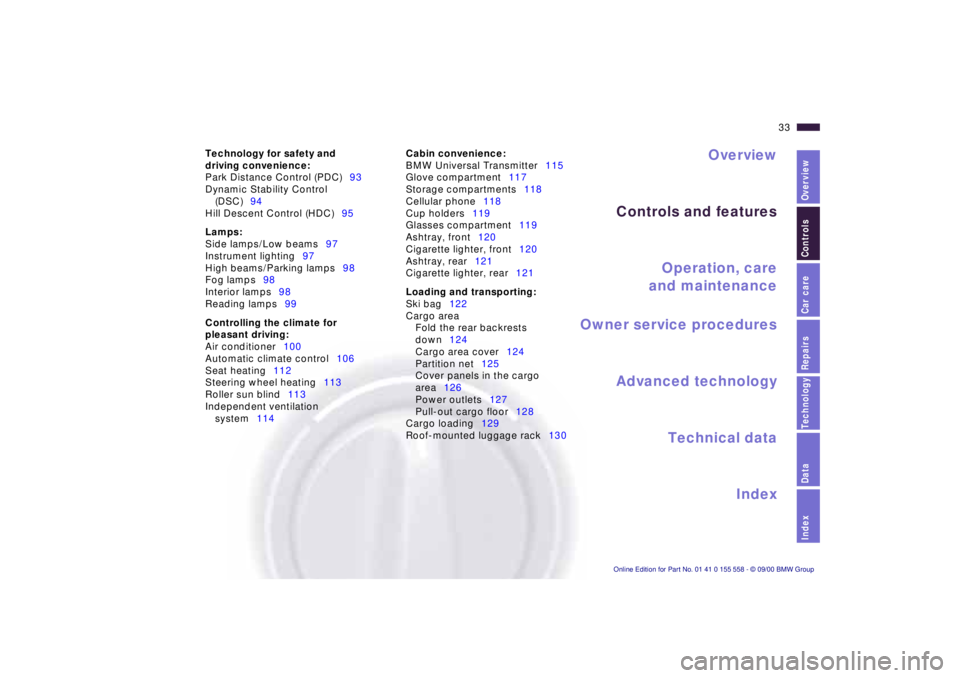
Index
Data
Technology
Repairs
Car care
Controls
Overview
Overview
Controls and features Operation, care
and maintenance
Owner service procedures
Technical dataIndex
Advanced technology
33
n
Technology for safety and
driving convenience:
Park Distance Control (PDC) 93
Dynamic Stability Control (DSC) 94
Hill Descent Control (HDC) 95
Lamps:
Side lamps/Low beams 97
Instrument lighting 97
High beams/Parking lamps 98
Fog lamps 98
Interior lamps 98
Reading lamps 99
Controlling the climate for
pleasant driving:
Air conditioner 100
Automatic climate control 106
Seat heating 112
Steering wheel heating 113
Roller sun blind 113
Independent ventilation system 114 Cabin convenience:
BMW Universal Transmitter
115
Glove compartment 117
Storage compartments 118
Cellular phone 118
Cup holders 119
Glasses compartment 119
Ashtray, front 120
Cigarette lighter, front 120
Ashtray, rear 121
Cigarette lighter, rear 121
Loading and transporting:
Ski bag 122
Cargo area Fold the rear backrests
down 124
Cargo area cover 124
Partition net 125
Cover panels in the cargo
area 126
Power outlets 127
Pull-out cargo floor 128
Cargo loading 129
Roof-mounted luggage rack 130
Page 34 of 223
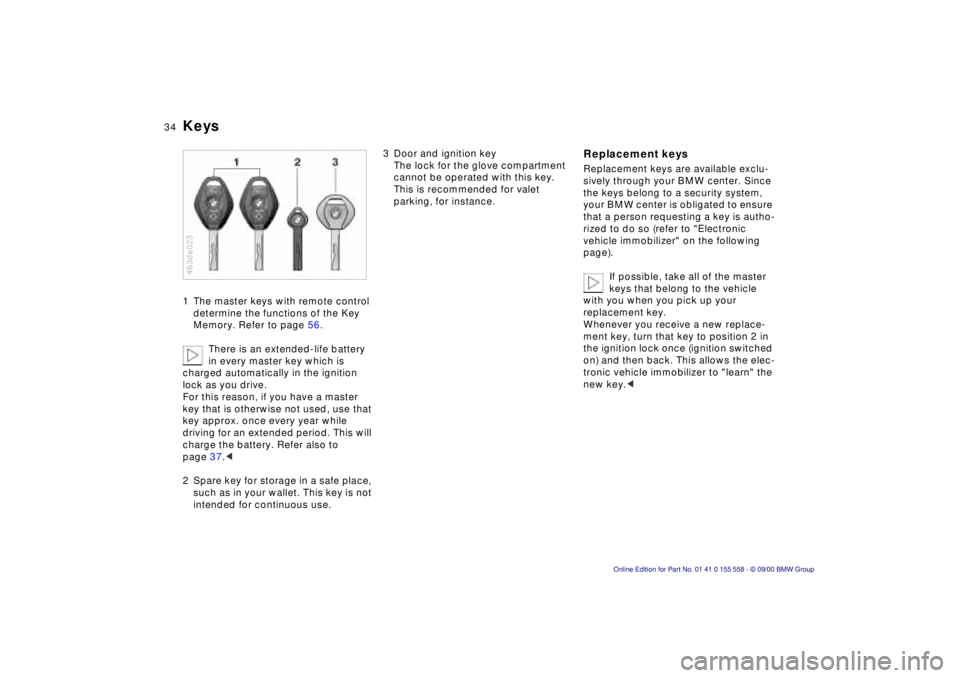
34nKeys
1 The master keys with remote control
determine the functions of the Key
Memory. Refer to page 56.
There is an extended-life battery
in every master key which is
charged automatically in the ignition
lock as you drive.
For this reason, if you have a master
key that is otherwise not used, use that
key approx. once every year while
driving for an extended period. This will
charge the battery. Refer also to
page 37.<
2 Spare key for storage in a safe place, such as in your wallet. This key is not
intended for continuous use.
463de023
3 Door and ignition keyThe lock for the glove compartment
cannot be operated with this key.
This is recommended for valet
parking, for instance. Replacement keys
Replacement keys are available exclu-
sively through your BMW center. Since
the keys belong to a security system,
your BMW center is obligated to ensure
that a person requesting a key is autho-
rized to do so (refer to "Electronic
vehicle immobilizer" on the following
page).
If possible, take all of the master
keys that belong to the vehicle
with you when you pick up your
replacement key.
Whenever you receive a new replace-
ment key, turn that key to position 2 in
the ignition lock once (ignition switched
on) and then back. This allows the elec-
tronic vehicle immobilizer to "learn" the
new key. <
Page 35 of 223
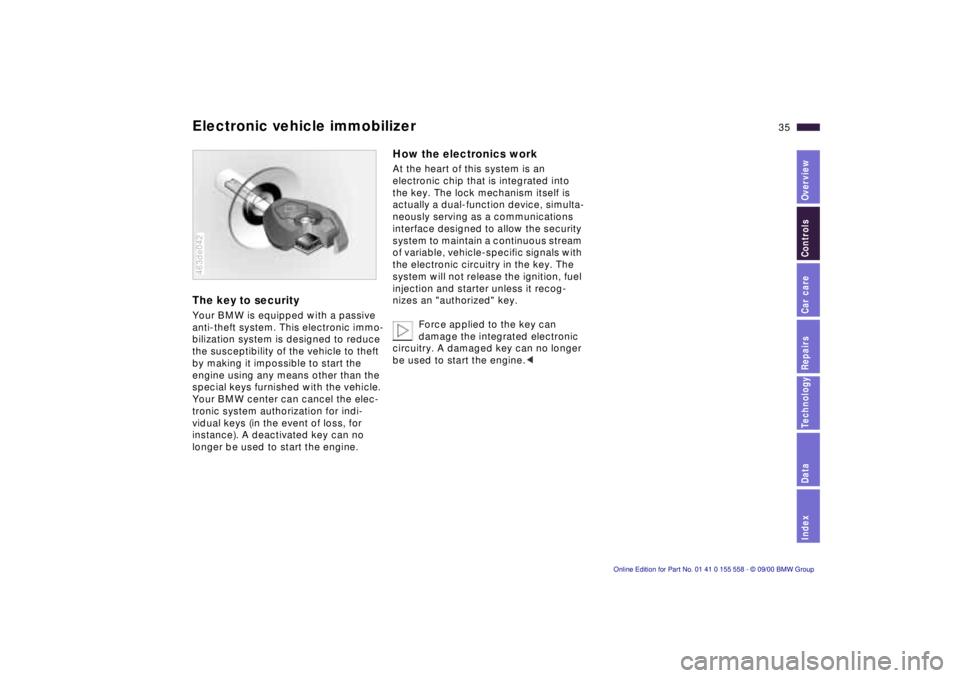
Index
Data
Technology
Repairs
Car care
Controls
Overview
35nElectronic vehicle immobilizer
The key to security
Your BMW is equipped with a passive
anti-theft system. This electronic immo-
bilization system is designed to reduce
the susceptibility of the vehicle to theft
by making it impossible to start the
engine using any means other than the
special keys furnished with the vehicle.
Your BMW center can cancel the elec-
tronic system authorization for indi-
vidual keys (in the event of loss, for
instance). A deactivated key can no
longer be used to start the engine.
463de042
How the electronics work
At the heart of this system is an
electronic chip that is integrated into
the key. The lock mechanism itself is
actually a dual-function device, simulta-
neously serving as a communications
interface designed to allow the security
system to maintain a continuous stream
of variable, vehicle-specific signals with
the electronic circuitry in the key. The
system will not release the ignition, fuel
injection and starter unless it recog-
nizes an "authorized" key.
Force applied to the key can
damage the integrated electronic
circuitry. A damaged key can no longer
be used to start the engine. <
Page 36 of 223
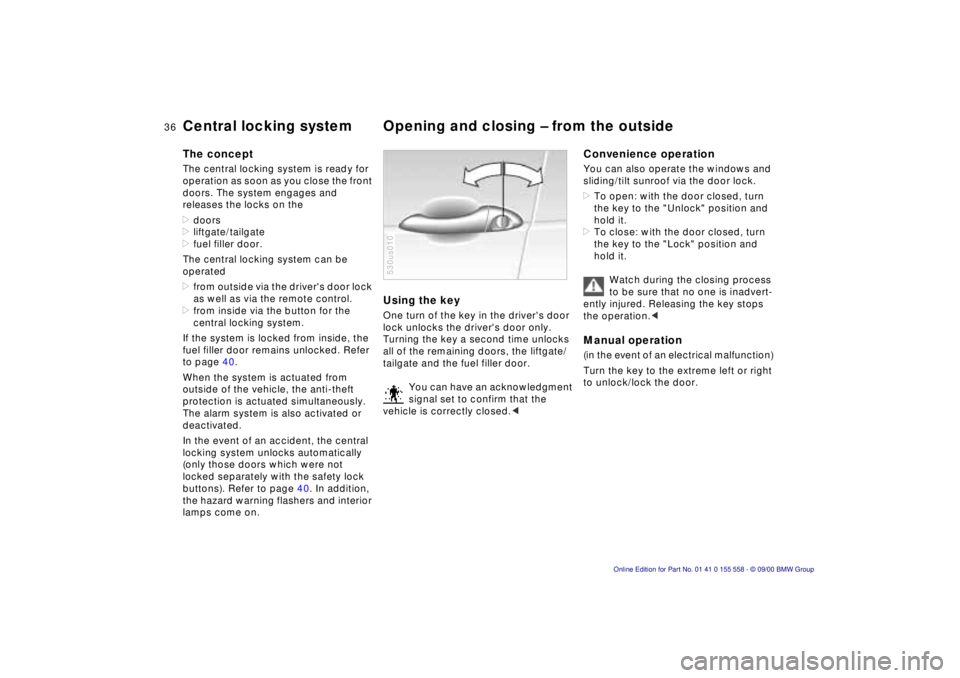
36nCentral locking system Opening and closing – from the outside
The concept
The central locking system is ready for
operation as soon as you close the front
doors. The system engages and
releases the locks on the
>doors
> liftgate/tailgate
> fuel filler door.
The central locking system can be
operated
> from outside via the driver's door lock
as well as via the remote control.
> from inside via the button for the
central locking system.
If the system is locked from inside, the
fuel filler door remains unlocked. Refer
to page 40.
When the system is actuated from
outside of the vehicle, the anti-theft
protection is actuated simultaneously.
The alarm system is also activated or
deactivated.
In the event of an accident, the central
locking system unlocks automatically
(only those doors which were not
locked separately with the safety lock
buttons). Refer to page 40. In addition,
the hazard warning flashers and interior
lamps come on.
Using the key
One turn of the key in the driver's door
lock unlocks the driver's door only.
Turning the key a second time unlocks
all of the remaining doors, the liftgate/
tailgate and the fuel filler door.
You can have an acknowledgment
signal set to confirm that the
vehicle is correctly closed. <
530us010
Convenience operation
You can also operate the windows and
sliding/tilt sunroof via the door lock.
> To open: with the door closed, turn
the key to the "Unlock" position and
hold it.
> To close: with the door closed, turn
the key to the "Lock" position and
hold it.
Watch during the closing process
to be sure that no one is inadvert-
ently injured. Releasing the key stops
the operation. <
Manual operation
(in the event of an electrical malfunction)
Turn the key to the extreme left or right
to unlock/lock the door.
Page 37 of 223
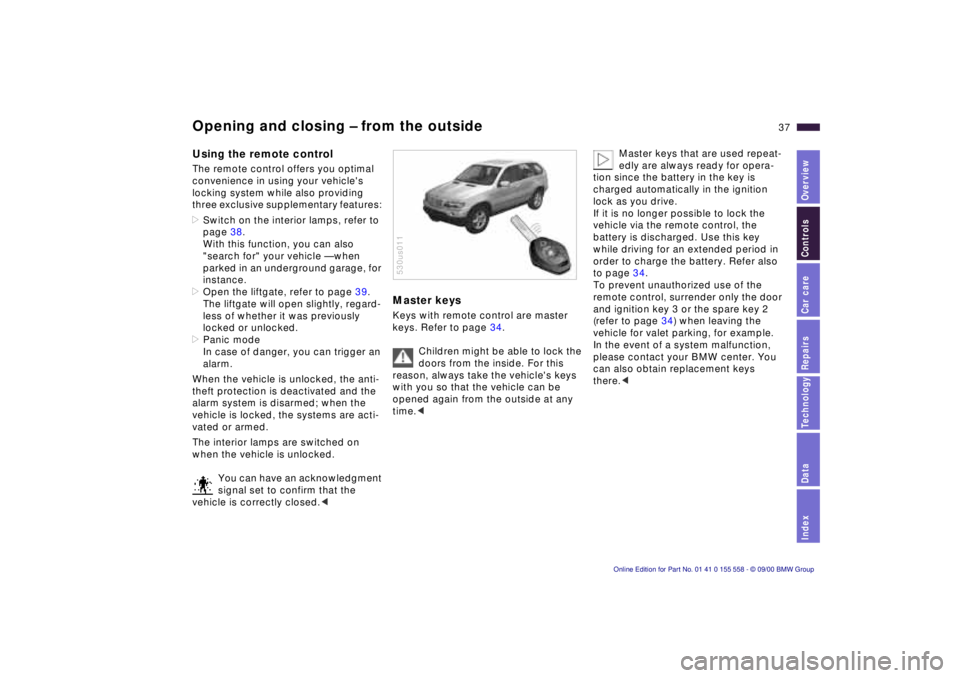
Index
Data
Technology
Repairs
Car care
Controls
Overview
37nOpening and closing – from the outside
Using the remote control
The remote control offers you optimal
convenience in using your vehicle's
locking system while also providing
three exclusive supplementary features:
>Switch on the interior lamps, refer to
page 38.
With this function, you can also
"search for" your vehicle — when
parked in an underground garage, for
instance.
> Open the liftgate, refer to page 39.
The liftgate will open slightly, regard-
less of whether it was previously
locked or unlocked.
> Panic mode
In case of danger, you can trigger an
alarm.
When the vehicle is unlocked, the anti-
theft protection is deactivated and the
alarm system is disarmed; when the
vehicle is locked, the systems are acti-
vated or armed.
The interior lamps are switched on
when the vehicle is unlocked.
You can have an acknowledgment
signal set to confirm that the
vehicle is correctly closed. <
Master keys
Keys with remote control are master
keys. Refer to page 34.
Children might be able to lock the
doors from the inside. For this
reason, always take the vehicle's keys
with you so that the vehicle can be
opened again from the outside at any
time. <
530us011
Master keys that are used repeat-
edly are always ready for opera-
tion since the battery in the key is
charged automatically in the ignition
lock as you drive.
If it is no longer possible to lock the
vehicle via the remote control, the
battery is discharged. Use this key
while driving for an extended period in
order to charge the battery. Refer also
to page 34.
To prevent unauthorized use of the
remote control, surrender only the door
and ignition key 3 or the spare key 2
(refer to page 34) when leaving the
vehicle for valet parking, for example.
In the event of a system malfunction,
please contact your BMW center. You
can also obtain replacement keys
there. <
Page 38 of 223
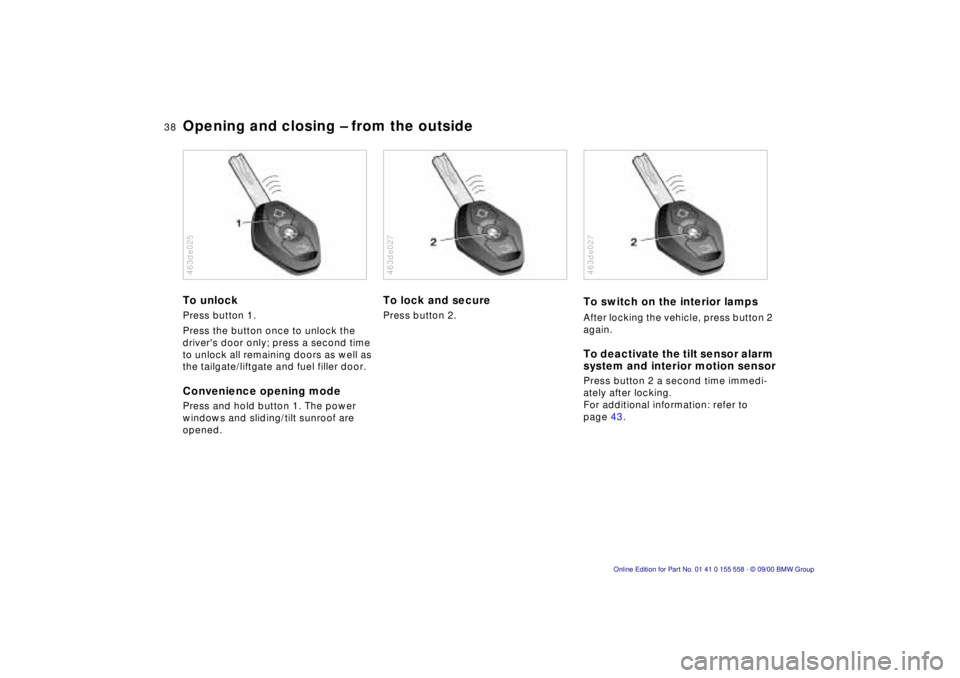
38nOpening and closing – from the outside
To unlock
Press button 1.
Press the button once to unlock the
driver's door only; press a second time
to unlock all remaining doors as well as
the tailgate/liftgate and fuel filler door.
Convenience opening mode
Press and hold button 1. The power
windows and sliding/tilt sunroof are
opened.
463de025
To lock and secure
Press button 2.
463de027
To switch on the interior lamps
After locking the vehicle, press button 2
again.
To deactivate the tilt sensor alarm
system and interior motion sensor
Press button 2 a second time immedi-
ately after locking.
For additional information: refer to
page 43.
463de027
Page 39 of 223
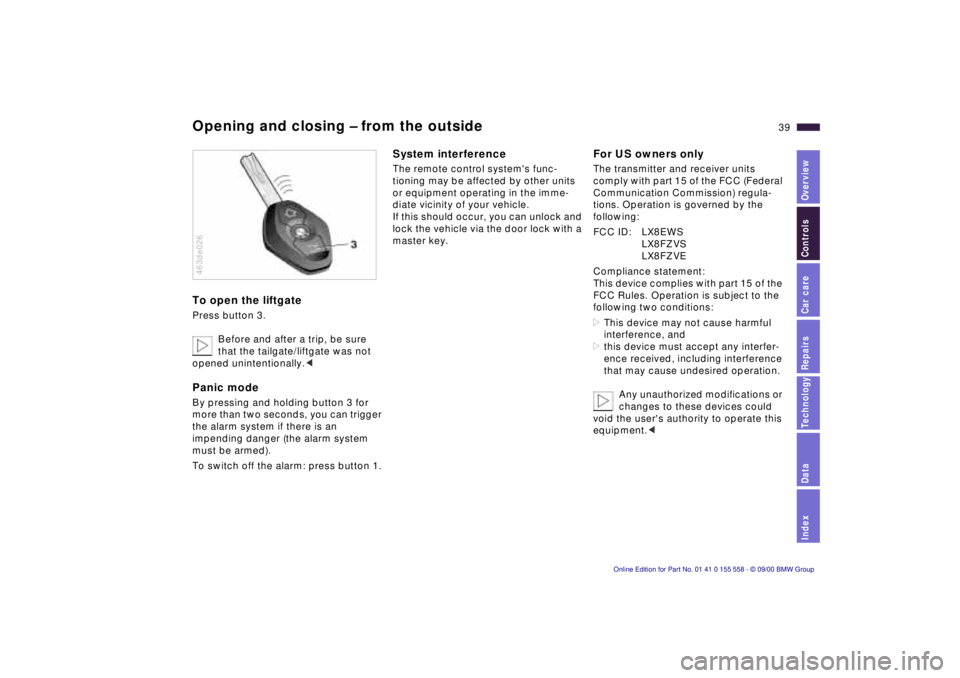
Index
Data
Technology
Repairs
Car care
Controls
Overview
39nOpening and closing – from the outside
To open the liftgate
Press button 3.
Before and after a trip, be sure
that the tailgate/liftgate was not
opened unintentionally. <
Panic mode
By pressing and holding button 3 for
more than two seconds, you can trigger
the alarm system if there is an
impending danger (the alarm system
must be armed).
To switch off the alarm: press button 1.
463de026
System interference
The remote control system's func-
tioning may be affected by other units
or equipment operating in the imme-
diate vicinity of your vehicle.
If this should occur, you can unlock and
lock the vehicle via the door lock with a
master key.
For US owners only
The transmitter and receiver units
comply with part 15 of the FCC (Federal
Communication Commission) regula-
tions. Operation is governed by the
following:
FCC ID: LX8EWS
LX8FZVS
LX8FZVE
Compliance statement:
This device complies with part 15 of the
FCC Rules. Operation is subject to the
following two conditions:
> This device may not cause harmful
interference, and
> this device must accept any interfer-
ence received, including interference
that may cause undesired operation.
Any unauthorized modifications or
changes to these devices could
void the user's authority to operate this
equipment. <
Page 40 of 223
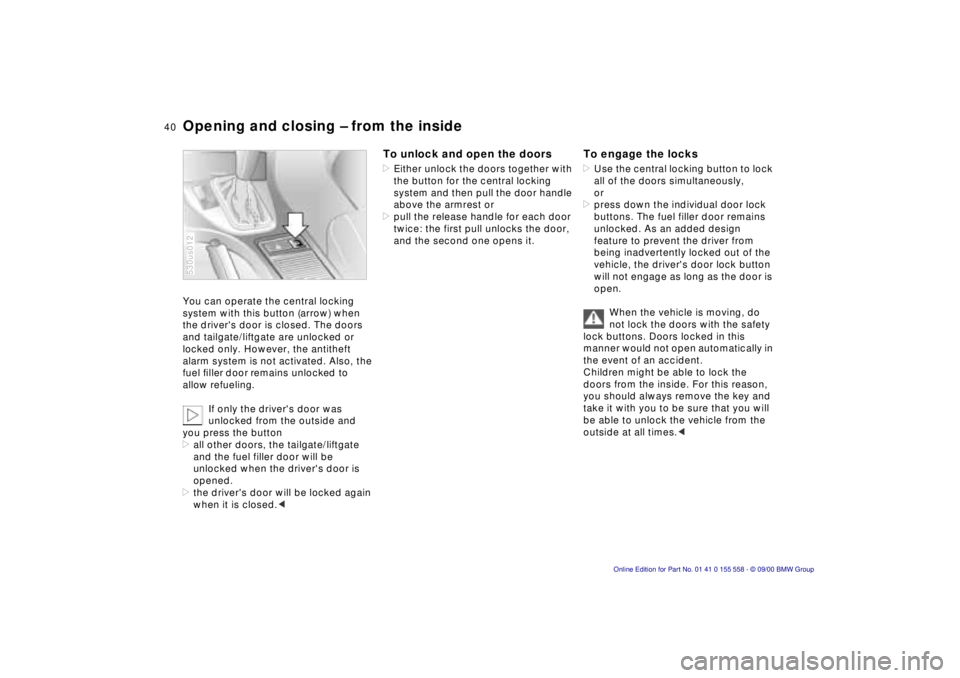
40nOpening and closing – from the inside
You can operate the central locking
system with this button (arrow) when
the driver's door is closed. The doors
and tailgate/liftgate are unlocked or
locked only. However, the antitheft
alarm system is not activated. Also, the
fuel filler door remains unlocked to
allow refueling.
If only the driver's door was
unlocked from the outside and
you press the button
> all other doors, the tailgate/liftgate
and the fuel filler door will be
unlocked when the driver's door is
opened.
> the driver's door will be locked again
when it is closed. <
530us012
To unlock and open the doors
> Either unlock the doors together with
the button for the central locking
system and then pull the door handle
above the armrest or
> pull the release handle for each door
twice: the first pull unlocks the door,
and the second one opens it.
To engage the locks
> Use the central locking button to lock
all of the doors simultaneously,
or
> press down the individual door lock
buttons. The fuel filler door remains
unlocked. As an added design
feature to prevent the driver from
being inadvertently locked out of the
vehicle, the driver's door lock button
will not engage as long as the door is
open.
When the vehicle is moving, do
not lock the doors with the safety
lock buttons. Doors locked in this
manner would not open automatically in
the event of an accident.
Children might be able to lock the
doors from the inside. For this reason,
you should always remove the key and
take it with you to be sure that you will
be able to unlock the vehicle from the
outside at all times. <